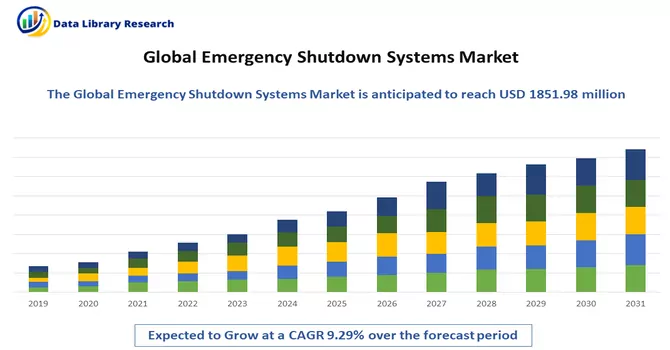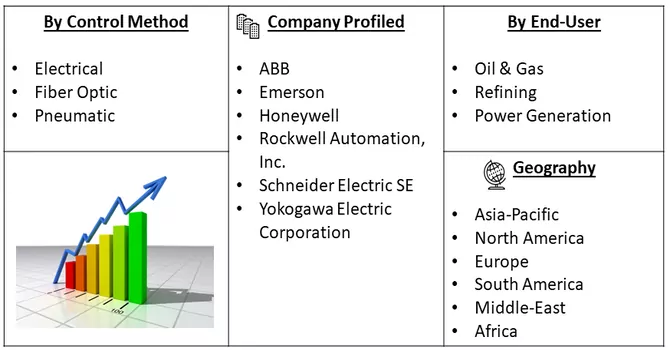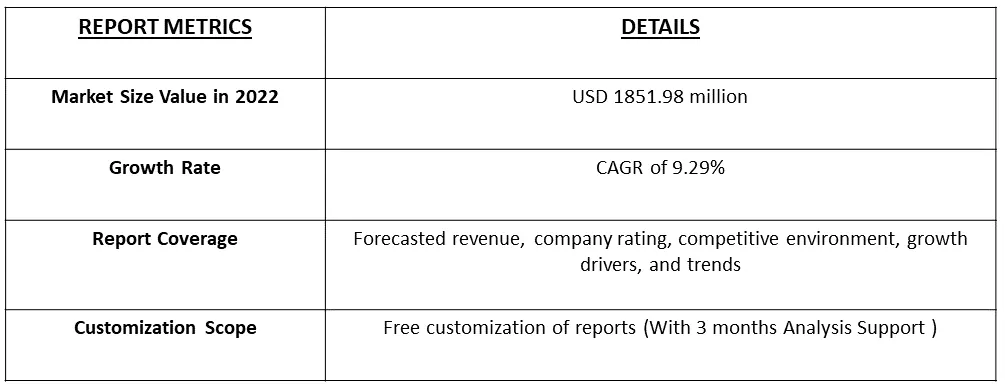The global emergency shutdown systems market was valued at USD 1851.98 million in 2022 and is expected a CAGR of 9.29% over the forecast period (2023-2030).

Get Complete Analysis Of The Report - Download Free Sample PDF
Emergency shutdown systems (ESD), also known as emergency shutdown (ES) or emergency isolation systems, are safety mechanisms and automated processes designed to swiftly and safely shut down critical operations or processes in industrial facilities, plants, and other applications in emergency situations. The primary purpose of these systems is to prevent or mitigate potentially dangerous situations, protect personnel, equipment, and the environment, and minimize the impact of accidents or emergencies. ESD systems are typically used in industries such as oil and gas, petrochemical, chemical, nuclear, and various manufacturing processes, where the rapid response to critical situations is essential. These systems can be activated manually by operators or automatically in response to predefined triggers like the detection of a fire, gas leaks, excessive pressure, temperature anomalies, or other hazardous conditions.
The increasing need for safety, the expansion of industrial activities, and technological advancements all contribute to the growth of the ESD market. Increasingly strict safety regulations and standards imposed by government agencies and industry bodies mandate the use of ESD systems to ensure the protection of personnel, equipment, and the environment. Compliance with these regulations is a major driver for the adoption of ESD systems. The prevention of industrial accidents is a top priority for high-risk industries such as oil and gas, petrochemicals, and chemicals. ESD systems are critical in minimizing the risk of catastrophic accidents by rapidly shutting down processes when hazardous conditions are detected.
Market Segmentation: The Emergency Shutdown Systems Market is segmented by Control Method (Electrical, Fiber Optic, Pneumatic), End-user Vertical (Oil & Gas, Refining, Power Generation), and Geography.

For Detailed Market Segmentation - Download Free Sample PDF
Market Drivers :
Stringent Regulatory Policies for Industrial Safety
Stringent regulatory policies aimed at enhancing industrial safety have emerged as a major driver for the global emergency shutdown systems market. Governments and regulatory bodies across the world have been implementing stricter safety measures, particularly in high-risk industries such as oil and gas, chemicals, and manufacturing. The demand for advanced emergency shutdown systems has surged as industries seek to comply with these regulations, reducing the risk of accidents, environmental damage, and the loss of human lives.
Growing Large-scale Production Projects due to Expansion of Oil and Gas Industry
The expansion of the oil and gas industry has significantly driven the demand for emergency shutdown systems. As the oil and gas sector continues to invest in large-scale production projects, the need for reliable and sophisticated emergency shutdown systems to ensure operational safety has grown. This expansion is particularly evident in regions such as the Middle East, North America, and Asia, further propelling the market's growth.
Moreover, n April 2020, the Emerson Industrial Energy consulting team undertook a project to support a specialty chemical manufacturer located in the Northeastern United States. This manufacturer faced the challenge of modernizing the control systems for two aging process steam boilers from the 1960s, which were of the Combustion Engineering "D" Type. To address this, Emerson developed and implemented a new control solution using DeltaV SIS (Safety Instrumented System) hardware to enhance safety functions and DeltaV PAS (Process Automation System) equipment to manage combustion and process control. This upgrade aimed to improve the efficiency and safety of the boiler operations in line with modern standards and technology. Thus, the market is expected to witness significant growth over the forecast period.
Market Restraints
High Initial and Maintenance Costs
One of the primary challenges faced by the emergency shutdown systems market is the high initial investment required for the implementation of these systems. Additionally, ongoing maintenance costs can be substantial, further adding to the financial burden for industries. The market must address these concerns by offering cost-effective solutions and emphasizing the long-term benefits of enhanced safety and risk mitigation.
The COVID-19 pandemic has had a mixed impact on the emergency shutdown systems market. On one hand, the demand for these systems remained resilient in essential industries such as healthcare, pharmaceuticals, and energy, driven by the increased emphasis on maintaining operational continuity and safety. On the other hand, the economic downturn and project delays in non-essential sectors led to a temporary reduction in demand. The market is expected to witness recovery as economies stabilize and industries resume projects.
Segmental Analysis:
Electrical Segment is Expected to Witness Significant growth Over the Forecast Period
The electrical industry plays a vital role in the emergency shutdown systems market. Electrical components and control systems are integral to the operation of emergency shutdown systems, ensuring the rapid and precise execution of safety protocols. A strong collaboration between the electrical and emergency shutdown system manufacturers is essential to provide seamless and dependable safety solutions. Innovations in electrical technology, such as advanced sensors and control systems, continue to enhance the performance of these systems.
Power Generation Segment is Expected to Witness Significant Growth Over the Forecast Period
The power generation industry relies on emergency shutdown systems to ensure the safe and efficient operation of power plants. Sudden shutdowns can have widespread consequences, including power outages and potential damage to equipment. As the demand for reliable and uninterrupted power supply grows, the power generation sector is a significant driver for the emergency shutdown systems market. Market growth is closely tied to the expansion of power generation capacity, renewable energy projects, and nuclear facilities.
Europe is Expected to Witness Significant Growth Over the Forecast Period
Europe stands as one of the world's major markets for emergency shutdown systems (ESD). The substantial activity in the downstream oil and gas sector and the robust industrial presence within the region serve as key catalysts propelling the ESD systems market in Europe. This continent boasts advanced and extensive crude oil refining capabilities, accounting for a significant 15% of the global oil refining capacity as of 2017. Recent challenges related to low crude oil prices have triggered a surge in demand for expanding existing refineries and initiating new projects, further stimulating the need for reliable ESD systems.
Exploration endeavors, particularly in countries like the United Kingdom, have yielded substantial results, with notable discoveries such as Glendronach (attributed to Total). The Glendronach discovery, identified as the fifth-largest conventional natural gas reserve on the UK Continental Shelf in the millennium, underscores the growing importance of the energy sector in Europe. Additionally, the increasing adoption of advanced industrial control systems across a wide array of end-user industries is expected to fuel the integration of emergency shutdown systems. This trend spans across large corporations as well as small and medium-sized enterprises, offering ample business opportunities for market players throughout the forecast period. Europe's dynamic industrial landscape and progressive energy sector position it as a lucrative market for ESD solutions. Thus, the region is expected to witness significant growth over the forecast period.

Get Complete Analysis Of The Report - Download Free Sample PDF
Growing demand for emergency shutdown systems is driving the huge investments in the industry, to develop new technological products. Owing to this, the companies have started adopting, developing new and differentiated products as their core strategy. Large manufacturers, aggressively pushing to acquire small tech companies and gain sustainable competitive advantage. Some of the key players in Global Emergency Shutdown Systems Market are:
Recent Development:
1. Apr 2020 - Emerson acquired leading hydroelectric turbine controls company, American Governor Company. The addition of American Governor Company builds on Emerson’s technology capabilities and expertise in the renewable and power industry.
2. Nov 2019 - Yokogawa Electric Corporation announced the release of ProSafe-RS R4.05.00, which is an enhanced version of the ProSafe-RS safety instrumented system. The ProSafe-RS is a core product of the OpreX Control and Safety System family offered by the company.
Q1. What was the Emergency Shutdown Systems Market size in 2022?
As per Data Library Research Emergency Shutdown Systems Market the global emergency shutdown systems market was valued at USD 1851.98 million in 2022.
Q2. At what CAGR is the Emergency Shutdown Systems Market projected to grow within the forecast period?
Emergency Shutdown Systems Market is expected a CAGR of 9.29% over the forecast period.
Q3. Which region has the largest share of the Emergency Shutdown Systems Market? What are the largest region's market size and growth rate?
Asia-Pacific region has the largest share of the market . For detailed insights on the largest region's market size and growth rate request a sample here.
Q4. What are the factors driving the Emergency Shutdown Systems Market?
Key factors that are driving the growth include the Stringent Regulatory Policies for Industrial Safety and Growing Large-scale Production Projects due to Expansion of Oil and Gas Industry.
Data Library Research are conducted by industry experts who offer insight on industry structure, market segmentations technology assessment and competitive landscape (CL), and penetration, as well as on emerging trends. Their analysis is based on primary interviews (~ 80%) and secondary research (~ 20%) as well as years of professional expertise in their respective industries. Adding to this, by analysing historical trends and current market positions, our analysts predict where the market will be headed for the next five years. Furthermore, the varying trends of segment & categories geographically presented are also studied and the estimated based on the primary & secondary research.
In this particular report from the supply side Data Library Research has conducted primary surveys (interviews) with the key level executives (VP, CEO’s, Marketing Director, Business Development Manager and SOFT) of the companies that active & prominent as well as the midsized organization
FIGURE 1: DLR RESEARH PROCESS

Extensive primary research was conducted to gain a deeper insight of the market and industry performance. The analysis is based on both primary and secondary research as well as years of professional expertise in the respective industries.
In addition to analysing current and historical trends, our analysts predict where the market is headed over the next five years.
It varies by segment for these categories geographically presented in the list of market tables. Speaking about this particular report we have conducted primary surveys (interviews) with the key level executives (VP, CEO’s, Marketing Director, Business Development Manager and many more) of the major players active in the market.
Secondary ResearchSecondary research was mainly used to collect and identify information useful for the extensive, technical, market-oriented, and Friend’s study of the Global Extra Neutral Alcohol. It was also used to obtain key information about major players, market classification and segmentation according to the industry trends, geographical markets, and developments related to the market and technology perspectives. For this study, analysts have gathered information from various credible sources, such as annual reports, sec filings, journals, white papers, SOFT presentations, and company web sites.
Market Size EstimationBoth, top-down and bottom-up approaches were used to estimate and validate the size of the Global market and to estimate the size of various other dependent submarkets in the overall Extra Neutral Alcohol. The key players in the market were identified through secondary research and their market contributions in the respective geographies were determined through primary and secondary research.
Forecast Model
